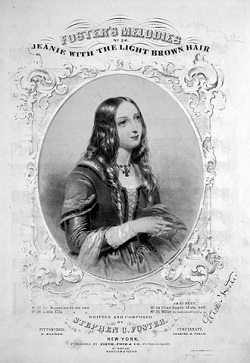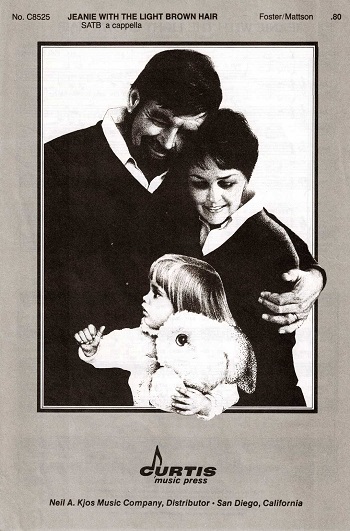
Poor Stephen Foster! He wrote a romantic song about his wife and it’s been turned into endless jokes. I’ve managed to find at least four “genie/hare” references just in old Bugs Bunny cartoons alone. And everyone knows how unbelievably awful the TV series “I Dream of Jeannie” was. (Yes. It was. No ifs, ands or buts about it.)
So, where to begin? That’s a frequent question in these posts. Let’s start with the hair, since it’s such a feature of the woman in the song. To say nowadays that someone has “light brown hair” isn’t exactly a compliment. It sounds blah, doesn’t it? Instead you’d probably say “dirty blonde,” although why that’s considered a flattering description is beyond me. Someone might have “ash blonde” hair that has no hint of red in it, but rarely would you say “ash brown,” even though that would just be a somewhat darker shade. On the other side of the spectrum you might call someone a “strawberry blonde,” but until I did some googling I’d never seen the term “strawberry brown.” It exists, though, as a light reddish brown. Kinda pretty, actually.
So who was this “Jeanie” (only one “n”)? Well, she was Stephen Foster’s wife whom he married in 1850. Foster, who died in poverty and alcoholism at age 38, is now known as one of America’s most well-known and prolific songwriters. He never profited as he deserved from his works during his lifetime, though, and his marriage to Jane McDowell, nicknamed “Jennie,” was very much an on-again, off-again relationship. Did she indeed have memorable hair? Well, according to a 499-page doctoral dissertation on Foster’s life and works (I admit to some very selective dipping), “she was called pretty, had light brown hair and according to the custom of the time it was long and ‘luxuriant’.” (quoted in Wikipedia) She left him for the first time of several in 1853 and the song was published the next year. He did use her actual nickname in his original title, but his publishers persuaded him that “Jeanie” was more pleasing to the ear than “Jennie.” Not sure I see the point, but there it is. Nor do I see any evidence that he ever tried to use the song in convincing her to return.
In fact, the “Jeanie” in the song is very different from the real one, as she’s very musical. The first verse says:
Many were the wild notes her merry voice would pour.
Many were the blithe birds that warbled them o’er:
In other words, just to belabor the point here, her singing is so attuned with nature (“wild notes”) that the birds actually warble her tunes. In reality, Foster’s actual wife was very uninterested in music, one of the many reasons why the two of them weren’t at all compatible.
Fun fact, though, about the song’s popularity: In 1941 radio stations refused to play music licensed through ASCAP (American Society of Composers, Authors and Publishers) because of an increase in fees, and so they played only public-domain or Broadcast Music International material. Apparently (why this was so is a little murky), “Jeanie” was played very frequently, so much so that Time magazine said, “So often had BMI’s Jeannie [sic] With the Light Brown Hair been played that she was widely reported to have turned grey.” Bing Crosby had popularized the song the previous year, and I speculate that perhaps his other songs were ASCAP licensed and so couldn’t be played, but I’m not sure. Whatever its reasons, though, that constant repetition seems to have been what burned the song into the general consciousness, even though the original association with Foster’s wife had been lost.
And I have to say that the lyrics don’t really call to mind a living person who could be asked to return to her lover. I’ll include a complete set of verses at the end of this post for you to see for yourself. She’s “the lost one that comes not again,” and that repeated line at the end of the first and last stanzas, “floating like a vapor on the soft summer air,” calls to mind a departed spirit and not someone still on earth. The arrangement that my own choir, the Cherry Creek Chorale, has programmed for a May 2022 concert (get your tickets now if you’re reading this post before that date and live in the Denver area) includes only the first verse, as does the 1940 Bing Crosby version that I assume is the one played on an endless loop the next year. I’ve included a recording of it below (he changed some of the words):
Here’s a lovely, lovely recording by a group called the John Halloran Singers, which at least includes the second verse as well. I’m going to guess that the album cover art depicts a scene from Harriet Beecher Stowe’s novel Uncle Tom’s Cabin. The richly-dressed white girl sitting with slaves in their quarters is almost certainly the character Little Eva. Foster arranged or wrote a number of spirituals or minstrel songs as well as his art songs, so that probably suggested the association. (Halloran, by the way, was apparently cheated out of credit and royalties for “The Little Drummer Boy.”)
Because I’m incurably trivia-minded (some would say, trivially minded), I can’t resist posting a couple of the Looney Tunes clips that include something vaguely resembling “Jeanie.” Believe me, I could have posted more!
In this clip Bugs shows up singing at about 1:07:
This clip includes just the “song.”
And here, as promised, are the complete lyrics:
I dream of Jeanie with the light brown hair,
Borne, like a vapor on the summer air;
I see her tripping where the bright streams play,
Happy as the daisies that dance on her way.
Many were the wild notes her merry voice would pour.
Many were the blithe birds that warbled them o’er:
Oh, I dream of Jeanie with the light brown hair,
Floating, like a vapor, on the soft summer air.
I long for Jeanie with a day-dawn smile,
Radiant in gladness, warm with winning guile;
I hear her melodies, like joys gone by,
Sighing round my heart over the fond hopes that die:—
Sighing like the night wind and sobbing like the rain,—
Wailing for the lost one that comes not again:
Oh, I long for Jeanie, and my heart bows low,
Never more to find her where the bright waters flow.
I sigh for Jeanie, but her light form strayed
Far from the fond hearts round her native glade;
Her smiles have vanished and her sweet songs flown,
Flitting like the dreams that have cheered us and gone.
Now the nodding wild flowers may wither on the shore
While her gentle fingers will cull them no more:
Oh, I sigh for Jeanie with the light brown hair,
Floating, like a vapor, on the soft summer air.
And a final little treat if you’ve persevered this far: a scan of the cover art for the arrangement that my choir is singing/sang in May 2022. I include it because it shows so clearly how the original meaning of the lyrics has been lost. Here’s what obviously seems to be a set of parents gazing down adoringly at a little girl with light-colored hair. (There’s no information at all in the sheet music giving credit for the picture.)

© Debi Simons


Whoops of course I meant Frost’s The Road Not Taken
Boy, you are SOOOOOOO GOOD! THANK YOU!